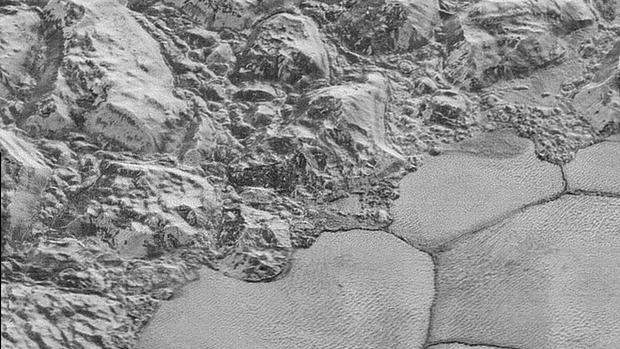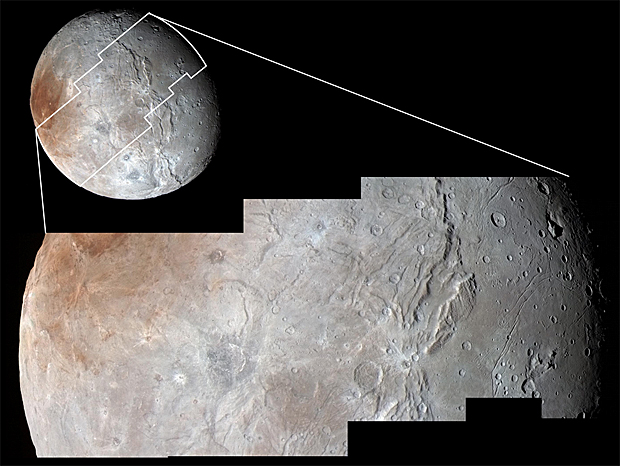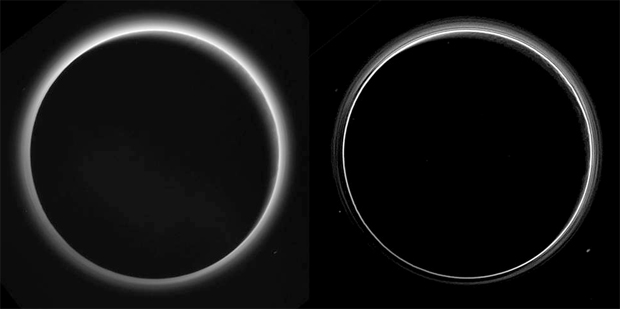Initial results from Pluto flyby fascinate - and baffle - scientists
The first scientific review of data collected during the New Horizons flyby of Pluto describe a small world with a thin but surprisingly complex atmosphere and a variety of surface features, ranging from ancient impact craters to geologically recent glaciers and other structures that reflect widespread resurfacing.
But in a paper published Thursday in the journal Science, New Horizons principal investigator Alan Stern and a team of co-investigators conclude that unlike other icy worlds, where resurfacing can result from tidal forces, "these are not a viable heat source today for Pluto or (its large moon) Charon."
"For Pluto, the rugged mountains and undulating terrain in and around (a heart-shaped area known as Tombaugh Regio) require geological processes to have deformed and disrupted Pluto's water ice-rich bedrock," they wrote.
"Some of the processes operating on Pluto appear to have operated geologically recently, including those that involve the water ice-rich bedrock as well as the more volatile, and presumably more easily mobilized, ices. ... This raises questions of how such processes were powered so long after the formation of the Pluto system."
Launched in January 2006, New Horizons flew past Pluto on July 14, passing within 7,770 miles of the dwarf planet's frigid surface, studying the world with a sophisticated suite of instruments as it approached and departed. It also studied Charon and Pluto's smaller moons Nix, Hydra, Styx and Kerberos.
Because of Pluto's enormous distance from Earth -- roughly 3 billion miles -- the power of New Horizons' radio transmitters and the size of its antenna, it will take some 16 months to downlink the 50 gigabits of data collected before, during and after the historic flyby.
But the images beamed back so far reveal a surprisingly complex world with a diameter of 1,475 miles that together with Charon, which has a diameter of 753 miles and orbits in gravitational lockstep every 6.4 days, make up the only known binary planet in the solar system.
Pluto shows no significant flattening, at the poles, indicating no evidence "of an early, high-spin period after Pluto-Charon binary formation," Stern concludes, "presumably because it was warm and deformable during or after tidal spindown."
But the surface of the world "displays a diverse range of landforms, as well as evidence for geological and other processes that have substantially modified its surface up to geologically recent times."
Widely distributed impact craters up to 180 miles across can be seen on the hemisphere facing New Horizons, many of which "appear to be substantially degraded or infilled, and some are highlighted by bright ice-rich deposits on their rims and/or floors," Stern and company write.
Some areas, like a region known as Cthulhu Regio, are "intensely cratered" with tectonic features "including scarps and troughs" stretching up to 370 miles long.
The heart-shaped Tombaugh Regio straddling the equator of the spacecraft-facing hemisphere measures roughly 1,100 miles by 930 miles. The western half of the region, known as Sputnik Planum, features relatively level plains with surrounding water-ice mountains towering 1.2 to 1.8 miles above the nearby terrain.
"These and other high, steep-sided topographic features seen across Pluto require materials that will not relax under their own weight on geologic time scales," Stern writes. "The nitrogen (N2), carbon monoxide (CO), and methane (CH4) ices that were known from ground-based spectroscopy to dominate Pluto's visible surface would collapse exceptionally rapidly because they are weak ... solids.
"The mountains detected by New Horizons imagery therefore imply the presence of a widespread, stronger, presumably water ice-based, solid 'bedrock.' We further conclude that the observed N2, CO, and CH4 ices must only be a surface veneer above this bedrock."
No significant impact craters, or remains of craters, can be seen in the generally smooth Sputnik Planum. But the icy plains appear to be divided into wide polygon- or oval-shaped cells surrounded by shallow troughs up to nearly 2 miles wide. Some troughs are darker than others and some are "traced by clumps of hills" that rise several hundred feet.
The origin of the polygonal features is not yet known. They could be the result of surface contractions like those seen in dried mud on Earth, the result of uplift from below or the result of the sun's weak radiation.
The central, brightest regions of Sputnik Planum are covered with nitrogen, methane and carbon monoxide ices and is "mostly bordered by locally higher terrain, which suggests that it fills a topographic basin," the researchers write. Also visible in the area are apparent glaciers made up of nitrogen, methane and carbon monoxide ices that appear to flow around obstructions.
"Varying crater abundances indicate wide-ranging surface ages on Pluto," Stern and his team conclude. The scarcity of any sizable impact craters in Sputnik Planum "imply active geomorphic processes within the last few hundred million years and possibly continuing to the present."
Resurfacing can be caused by erosion and deposition, crater "relaxation," crust recycling via tectonic activity, tidal stresses or some combination of processes. But none of those processes appear to be at work on Pluto or Charon.
"As such, the young surface units on Pluto present a puzzle regarding the energy source(s) that power such resurfacing over time scales of billions of years," Stern writes.
After passing by Pluto, New Horizons snapped photos of the dwarf planet as it receded, recording how sunlight passing through Pluto's tenuous mostly nitrogen atmosphere was affected. A global atmospheric haze was seen extending to an altitude of nearly 100 miles.
The atmosphere is slightly cooler than expected, with a slightly lower-than-expected surface pressure, but it's not yet clear whether a real difference has been seen or whether the difference is due to calibration issues between the Earth- and space-based measurements.
Pluto's large moon, Charon, is providing its own share of surprises. The moon has a diameter of 753 miles and, like Pluto, displays a wide range of surface features. Extensive cratering is seen, along with smooth plains and huge chasms stretching more than 650 miles across the hemisphere visible to New Horizons.
Charon's north polar region appears dark and reddish in color, consistent with the presence of tholins, organic residues formed when ultraviolet radiation or charged particles interact with nitrogen and methane mixtures.
"One hypothesis for the reddish coloration is seasonal cold trapping of volatiles (which easily evaporate) at Charon's poles followed by energetic radiation processing into more chemically complex, less volatile tholins that can remain after the pole emerges back into sunlight," Stern writes.
New Horizons also aimed its instruments at Pluto's four other moons -- Nix, Hydra, Styx and Kerberos -- during the flyby, but only a handful of Nix and Hydra images has been downlinked to date. No other moons, or any evidence of a ring system, have been seen.
Both Nix and Hydra are highly reflective, indicating the presence of relatively clean water ice -- another mystery.
"How such bright surfaces can be maintained on Nix and Hydra over billions of years is puzzling, given that a variety of external processes ... would each tend to darken and redden the surfaces of these satellites over time."
While the bulk of New Horizons' observations has yet to make it back to Earth, researchers have seen enough to draw at least one wide-ranging conclusion about the origin and evolution of the Pluto-Charon system.
"The New Horizons encounter with the Pluto system revealed a wide variety of geological activity -- broadly taken to include glaciological and surface-atmosphere interactions as well as impact, tectonic, cryovolcanic, and mass-wasting processes on both the planet and its large satellite Charon," they write.
"This suggests that other small planets of the Kuiper Belt, such as Eris, Makemake, and Haumea, could also express similarly complex histories that rival those of terrestrial planets such as Mars, as Pluto does."





